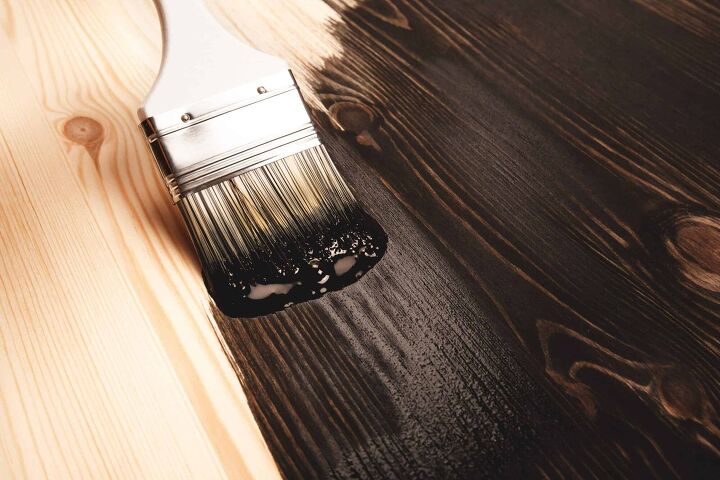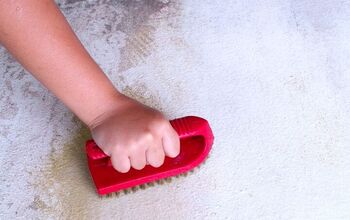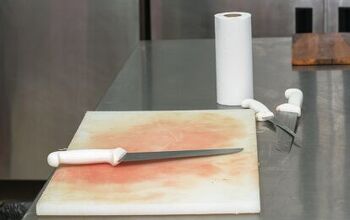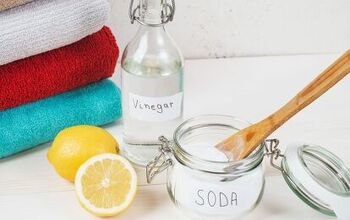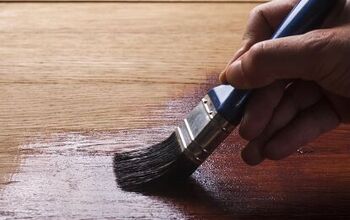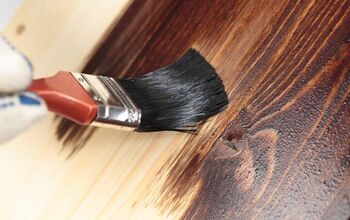How To Remove Excess Stain That Has Dried

You got your new floors installed sanded and stained. In the excitement, you forgot to wipe off the excess stain and it has dried, leaving the floor dark and blotchy. Is all your hard work about to be undone? How can you remove the excess stain that has dried?
To remove the excess stain that has dried, use a soft clean cloth soaked in mineral spirits and rub the cloth over the dried stain to soften. After, wipe the excess stain with a clean, lint-free cloth. Keep on wiping until the excess stain is removed. You may have to scrub.
In some cases, you may have to take more drastic measures to remove the excess stain or to get the color that you want on your floor. Most of these methods for removing excess stain are well within the capability of most do-it-yourselfers.
Do You Need Painting or Staining Services?
Get free, zero-commitment quotes from pro contractors near you.

Soften and Wipe the Excess Stain Away
The easiest and quickest way to remove any excess stain inadvertently left on a floor is to soften the stain and wipe it away. With just a few simple tools and some mineral spirits, you can remove the excess stain and even out the blotchy appearance of your stain.
Step 1 – Get the Materials and Tools
Gather all the tools and supplies you will need. Have a good supply of soft, clean, lint-free cloths, mineral spirits, steel wool, rubber gloves, and eye protection. It may be difficult to judge how much mineral spirits you may need.
Step 2 – Work Small
Work in small areas. It is better to clean a smaller area that you can easily handle. If you try tackling huge areas, you risk letting the softened stain dry. Work only as much area as you can complete before the stain starts to harden again.
Step 3 – Soften the Excess Stain
Wear your gloves and eye protection. If you are sensitive to the odor of mineral spirits, you may want to wear a respirator. Wet a soft cloth with mineral spirits and wipe onto the area on which you are working.
Keep the cloth damp and work the area until the excess stain begins to soften.
Step 4 – Wipe the Excess Stain Away
Using a fresh, clean, lint-free cloth and wipe away the excess stain. Continue wiping until you achieve the stain color that you want and the stain is even. You may need to reapply mineral spirits if the excess stain is thick.
Step 5 – Let the Surface Dry Completely
When you have the stain to the color you want, let it dry. Follow the manufacturer’s recommendations on drying time. In general, you should let the cleaned surface dry for at least 24 hours before applying the finish coats.
Step 6 – Apply the Finish Coat
When the stain has dried completely and is no longer tacky to the touch, it is safe to apply your finish coat. Again, follow the manufacturer’s instructions on applying the finish coat.
How to Loosen Stubborn Stain
You may need to resort to chemicals to remove the excess dried stain on your floor. There are two types of chemical products that you may consider.
Chemical Strippers
Chemical paint and stain strippers are one solution to excess stain that has dried on your floor. Typically, the chemical stripper is brushed onto the surface and allowed to sit. After an appropriate time, then you scrape the stripper away, lifting the surface finish at the same time.
If the excess stain has had a long time to dry and setup, the mineral spirits may not work effectively to remove the excess stain. There are products available that will work to remove this excess stain. The downside to these methods is the caustic nature of the products.
If you must use one of these products, it is extremely important to follow the directions given by the manufacturer.
Bleaching Agents
Bleaching agents are chemicals like stripping agents. In general, you use these products in the following manner.
Step 1 – Remove all the Excess Stain You Can
Use the process outlined above to remove as much of the excess stain possible. It is important to understand that the two-part products don’t remove heavy accumulations of excess stain. These products bleach or lighten the stain on the wood.
Step 2 – Let the Floor Dry Completely
Before you apply the bleaching agents, let the floor surface dry completely. A dry surface is important to prevent bleaching agents from reacting with the minerals spirits. These chemical reactions can damage the wood or create blotchy appearances.
Step 3 – Apply the Bleaching Agent – Follow the Directions
Follow the directions that came with the bleaching agent carefully. Many of these products are very caustic or acidic and require the appropriate safety precautions. Eye protection, gloves, and long sleeves are the minimum. Work safely.
Some of these products come in two parts. You must premix the two parts to the exact ratios in the directions. Mis-mixing the two parts can result in unwanted or unexpected results when the bleaching agents start to work on your floor.
Step 4 – Stop the process – Neutralization
Many of these bleaching agents need a neutralizing agent to stop the chemical reaction when the stain has reached the color you desire. The direction on the bleaching agent will tell you specifically how to neutralize the bleaching process.
Step 5 – Rinse and Clean the Surface
Before you can apply your finish coat, the surface must be clean and dry. You must remove any of the neutralized bleaching agents before you go any further. The product you are using must be your guide to how to clean the surface.
Failure to adequately clean the bleaching material from the surface can result in the finish coat not curing properly. The reaction may also change the color of the finish coat, which can affect the floor’s color.
Step 6 – Appy your Finish Coat
If things are looking good on your floor, you can apply your finish coat. Follow the directions on the finish coat material that you are using.
Correcting A Splotchy Floor
It is hard to predict how the bleaching agent may affect the color and application of stain. In some instances, the bleaching agent may react unevenly and leave a splotchy appearance. In this case, there are several alternatives.
Use a Gel Stain to Even the Color
One solution to splotchy stain is to apply another coat of a high-quality gel stain. Apply the gel stain per the directions and wipe it off immediately. Let the gel stain dry completely. A gel stain may help even out the splotchy appearance. Remember that gel stains take more time to dry.
If All Else Fails – Start Over
If all the other remedies fail and your floor doesn’t meet your expectations, there is but one alternative. About the only thing left to do is grab your sander and start over. It is a hard decision to make, but there are times when a bad stain job leaves you with no alternative.
Do You Need Painting or Staining Services?
Get free, zero-commitment quotes from pro contractors near you.

Getting The Results You Want
Trying to recover from an unanticipated problem when applying stain can get labor-intensive and involved. Following the instructions above can help mediate an excess of dried stain on your new or refinished floors.
Of course, the ideal situation is no excess stain on the floor. But accidents happen and we can’t always prevent some of these situations. We hope this article has given you some insight into how to mitigate an excess of dried stain on your floor.

Dennis is a retired firefighter with an extensive background in construction, home improvement, and remodeling. He worked in the trades part-time while serving as an active firefighter. On his retirement, he started a remodeling and home repair business, which he ran for several years.
More by Dennis Howard



